| The IEEE North American School
on Information Theory delivers interactive education for graduate
students in the engineering and mathematical sciences, and the opportunity
to meet with distinguished lecturers and peers in a supportive environment.
Information Theory studies the transmission, processing, and use
of information in many contexts; it draws from and contributes to
a large number of disciplines in the mathematical sciences. The
areas of study of participants are expected to include pure mathematics,
theoretical computer science, and the engineering sciences. The
types of research topics presented by students, and the tutorial
areas discussed by lecturers, will span foundational theory, algorithmic
design, and implementation in practice.
In its seventh year, this event is designed to provide graduate
students with opportunities to:
- Learn from distinguished lecturers in the field who will present
long-format (2 1/2 hour) tutorials;
- Participate in a stimulating and inviting forum of scientists;
- Present their own work for feedback and potential collaboration;
- Deepen their connections with the community
|
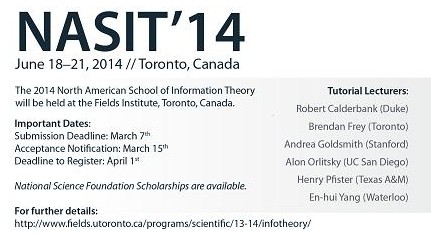 |
The 15th IEEE International Workshop on Signal
Processing Advances in Wireless Communications ( SPAWC
2014) will be held right after NASIT. |
Lecturers:
- Robert Calderbank, Duke
- Brendan Frey, Toronto
- Andrea Goldsmith, Stanford
- Alon Orlitsky, UCSD
- Henry Pfister, Texas A&M
- En-hui Yang, Waterloo
Poster Session
As part of NASIT, there will be a poster session each day. The idea
of the sessions is to provide an informal and relaxed setting for students
to interact with other students and faculty to get experience in presenting
and to discuss their ideas and their research; students will be required
to present a poster in one of the three sessions. We encourage more
junior graduate students, who do not yet have original research to present
at NASIT, to present a "tutorial-style" poster on some topic
of interest to the student. To more advanced graduate students and post-docs
we note that posters are not refereed, and that previously published
results are completely acceptable.
In addition, the school will feature interactive panels and poster
sessions, as well as social and technical student events.
Tutorials
 Tutorial
1 (Wednesday June 18, AM) Tutorial
1 (Wednesday June 18, AM)
Information Theory and Learning: The Grace of Dimensionality
Speaker: Alon Orlitsky, UCSD
Information theory uses data to effectively perform various tasks.
In these two lectures we apply it to the machine-learning tasks of
estimation, prediction, and classification, over discrete and continuous
domains. For discrete domains we show that these tasks require a number
of samples that tends to infinity as the domain size increases, and
that a simple and natural modification of the tasks requires only
a constant number of samples for any domain size. For continuous domains
we construct an intuitive spectral estimator that learns high-dimensional
Gaussian mixtures with a near-optimal number of samples.
Based on joint work with Jayadev Acharya, Ashkan Jafarpour, and Ananda
Theertha Suresh.
Bio: Alon Orlitsky received B.Sc. degrees in Mathematics and Electrical
Engineering from Ben Gurion University in 1980 and 1981, and M.Sc. and
Ph.D. degrees in Electrical Engineering from Stanford University in
1982 and 1986. From 1986 to 1996 he was with the Communications Analysis
Research Department of Bell Laboratories. He spent the following year
as a quantitative analyst at D.E. Shaw and Company, an investment firm
in New York city. In 1997 he joined the University of California, San
Diego, where he is currently a professor of Electrical and Computer
Engineering and of Computer Science and Engineering, and directs the
Information Theory and Applications Center and the Center for Wireless
Communications. His research concerns information theory, statistical
modeling, and machine learning. He is a recipient of the 1981 ITT International
Fellowship and the 1992 IEEE W.R.G. Baker Paper Award, and co-recipient
of the 2006 Information Theory Society Paper Award. He co-authored two
papers for which his students received student-paper awards: the 2003
Capocelli Prize and the 2010 ISIT Student Paper Award. He is a fellow
of the IEEE, and holds the Qucalcomm Chair for Information Theory and
its Applications at UCSD.
Tutorial 2 (Wednesday June 18, PM)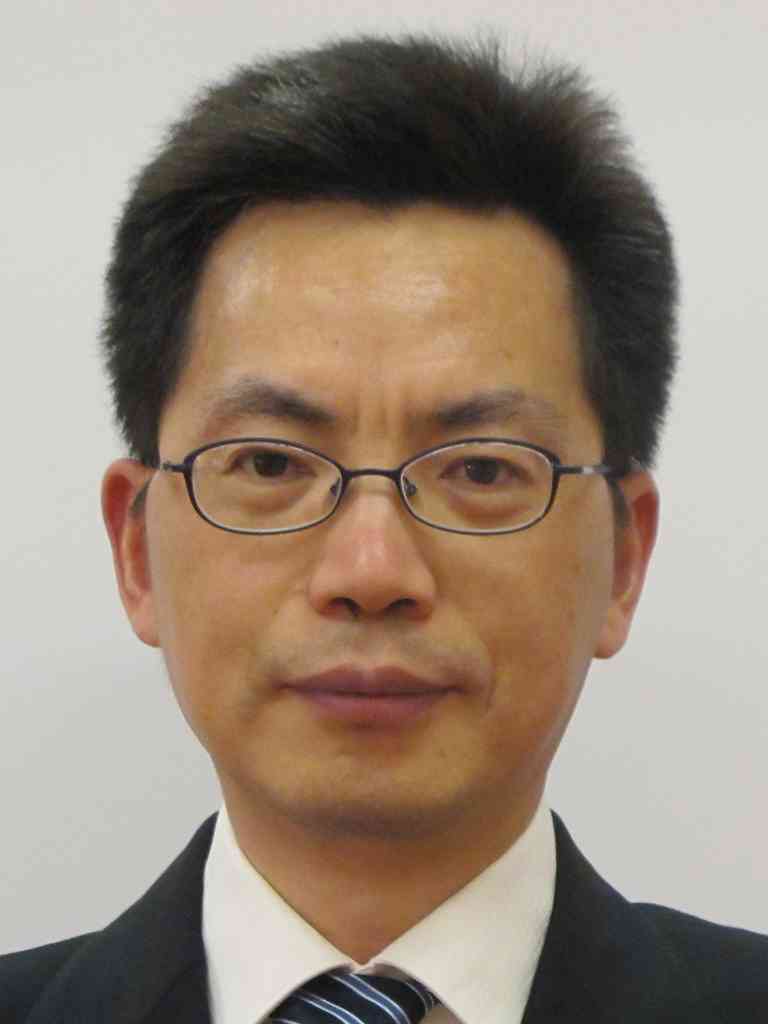
Source Coding Theory and Practice: Making and Connecting
Dots
Speaker: En-hui Yang, University of Waterloo
Rene Descartes (1596--1650), the father of modern philosophy and
analytic geometry, stated, ``it is necessary that at least once in
your life you doubt, as far as possible, all things,'' and tried to
use what is now known as ``the method of doubt'' to establish a firm,
rational foundation for knowledge. To many, information and knowledge
may be regarded as the two sides of a coin. As such, it would be interesting
to see if the method of doubt can be used to advance information theory
(IT) research as well.
Taking source coding as an example, we will illustrate in this lecture
how to use the method of doubt to make and connect dots in source
coding theory and practice. After reviewing Shannon's probabilistic
approach to source coding, we will use the method of doubt to challenge
assumptions made therein, derive the computational approach to both
lossless and lossy compression, demonstrate the consistency between
the computational approach and probabilistic approach whenever those
assumptions are valid, and discuss the recent successful applications
of the computational approach to image and video coding, and its impacts
on the design of HEVC, the newest video coding standard, and future
video coding standards. Using the method of doubt again, we would
challenge the existing video coding paradigm, especially in mobile
video, and present a new video coding paradigm dubbed causal video
coding along with some counter intuitive IT research results. Finally,
using the method of doubt, we would connect source coding with the
display and management of Big Data and machine learning by pointing
out some new IT problems and, if time permitting, demonstrating some
of our practical solutions.
Bio: En-hui Yang has been with the Dept. of Electrical and Computer
Engineering, University of Waterloo, Ontario, Canada since June 1997,
where he is now a Professor and Canada Research Chair in information
theory and multimedia compression. He is the founding director of the
Leitch-University of Waterloo multimedia communications lab, and a co-founder
of SlipStream Data Inc. (now a subsidiary of BlackBerry (formerly Research
In Motion)). He currently also serves as an Executive Council Member
of China Overseas Exchange Association and an Overseas Advisor for the
Overseas Chinese Affairs Office of the City of Shanghai, and is sitting
on the Overseas Expert Advisory Committee for the Overseas Chinese Affairs
Office of the State Council of China and a Review Panel for the International
Council for Science.
Tutorial 3: (Thursday June 19 AM)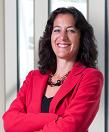
Wireless networks: dreams, challenges, and capacity
limits
Speaker: Andrea Goldsmith, Stanford University
Wireless networks have fundamentally altered the way we live, work,
and play. This talk focuses on the use of information theory to obtain
fundamental capacity limits as well as design insights forthese networks.
Building up from first principles, we will cover capacity analysis
for single-user and multi-user channels as well as ad-hoc networks
and cellular systems, including the impact of time-varying fading
and ISI. We will also explore how fundamental capacity limits outside
"asymptopia," i.e. under finite delay, energy, and sampling
constraints,are obtained. The talk concludes by speculating onwhat
the wireless future might look like and describing some of the innovations
and insights that are required to realize this vision.
Bio: Andrea Goldsmith is the Stephen Harris professor in the School
of Engineering and a professor of Electrical Engineering at Stanford
University. She was previously on the faculty of Electrical Engineering
at Caltech. She co-founded and served as CTO of Accelera, Inc. and of
Quantenna Communications, Inc. and has also held industry positions
at Maxim Technologies, Memorylink Corporation, and AT&T Bell Laboratories.
Dr. Goldsmith is a Fellow of the IEEE and of Stanford, and she has received
several awards for her work, including the IEEE Communications Society
and Information Theory Society joint paper award, the IEEE Communications
Society Best Tutorial Paper Award, the National Academy of Engineering
Gilbreth Lecture Award, the IEEE ComSoc Communications Theory Technical
Achievement Award, the IEEE ComSoc Wireless Communications Technical
Achievement Award, the Alfred P. Sloan Fellowship, and the Silicon Valley/San
Jose Business Journal's Women of Influence Award. She is author of the
book ``Wireless Communications'' and co-author of the books ``MIMO Wireless
Communications'' and "Principles of Cognitive Radio," all
published by Cambridge University Press. She received the B.S., M.S.
and Ph.D. degrees in Electrical Engineering from U.C. Berkeley.
Dr. Goldsmith has served as editor for the IEEE Transactions on Information
Theory, the Journal on Foundations and Trends in Communications and
Information Theory and in Networks, the IEEE Transactions on Communications,
and the IEEE Wireless Communications Magazine as well as on the Steering
Committee for the IEEE Transactions on Wireless Communications. She
participates actively in committees and conference organization for
the IEEE Information Theory and Communications Societies and has served
on the Board of Governors for both societies. She has also been a Distinguished
Lecturer for both societies, served as President of the IEEE Information
Theory Society in 2009, founded and chaired the student committee of
the IEEE Information Theory Society, and chaired the Emerging Technology
Committee of the IEEE Communications Society. At Stanford she received
the inaugural University Postdoc Mentoring Award and has been active
in committees to innovate and revise both graduate and undergraduate
education university-wide. She served as Chair of Stanford's Faculty
Senate in 2009 and currently serves on its Faculty Senate and on its
Budget Group.
Tutorial 4: (Thursday June 19 PM)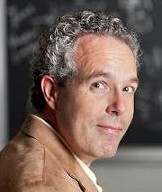
Decoding the Genome
Speaker: Brendan Frey, University of Toronto
The digital code that controls the biochemistry of life is embedded
within a sequence of DNA letters called a genome. Recently, scientists
have figured out the code embedded in the ten thousand-letter HIV
genome and have successfully modified the code in a one million-letter
bacterial genome. However, we are only beginning to understand the
human code, which resides in a three billion-letter genome and makes
use of combinatorial complexity to generate hundreds of different
cell types comprising trillions of cells in the human body. I will
describe recent discoveries made by my colleagues and I, which shed
light on how the human code works, how it is used to generate complex
cell types, and how it differs from other species, such as chimpanzees.
I will also describe how the human code can be used to understand
the genetic causes of human disease and even to treat disease.
Bio: Dr. Brendan J Frey is a Professor at the University of Toronto,
with appointments in Engineering and Medicine. He conducts research
in the fields of genome biology and machine learning. Dr. Frey holds
the Canada Research Chair in Biological Computation, and is a Fellow
of the Canadian Institute for Advanced Research, the Institute of Electrical
and Electronic Engineers and the American Institute for the Advancement
of Science. He has received several distinctions, including the John
C Polanyi Award, the EWR Steacie Fellowship and Canada's Top 40 Leaders
Under 40 Award. Dr. Frey has consulted for several industrial research
and development laboratories in Canada, the United States and England,
and he is currently on the Technical Advisory Board of Microsoft Research.
His former students and postdoctoral fellows include professors, industrial
researchers and developers at universities and industrial laboratories
from across Canada, the United States and Europe.
Tutorial 5 (Friday June 20 AM)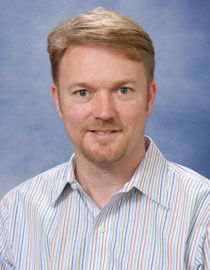
A Brief Introduction to Spatially-Coupled Codes and
Threshold Saturation
Speaker: Henry Pfister, Texas A&M
It is well-known that belief-propagation (BP) decoding of low-density
parity-check (LDPC) codes is suboptimal and that the noise threshold
of maximum-a-posteriori (MAP) decoding can be larger than that of
BP decoding. Recently, Kudekar et al. proved that regular LDPC ensembles
can be spatially coupled (SC) so that the BP noise threshold saturates
to the MAP noise threshold of the original ensemble. These SC ensembles
are instances of LDPC convolutional (LDPCC) codes and the new proof
explains an earlier observation by Lentmaier et al. that terminated
LDPCC codes allow reliable communication at rates approaching capacity.
The goal of this lecture is to provide a tutorial introduction to
these recent advances in coding theory. A short review of LDPC codes
and density evolution will be followed by an introduction to SC codes.
Next, some standard communication problems will be used to highlight
the benefits of SC codes. Finally, the phenomenon of threshold saturation
will be discussed and an overview of it.
This lecture is based on joint research with Yung-Yih Jian, Santhosh
Kumar, Krishna R. Narayanan, Phong S. Nguyen, and Arvind Yedla.
Henry D. Pfister received his Ph.D. in electrical engineering from UCSD
in 2003 and joined the faculty of the School of Engineering at Texas
A&M University in 2006, where he is currently an associate professor.
Prior to that he spent two years in R&D at Qualcomm, Inc. and one
year as a post-doc at EPFL. He received the NSF Career Award in 2008,
the Texas A&M ECE Department Outstanding Professor Award in 2010,
and was a coauthor of the 2007 IEEE COMSOC best paper in Signal Processing
and Coding for Data Storage. He is currently an associate editor in
coding theory for the IEEE Transactions on Information Theory.
His current research interests include information theory, communications,
and probabilistic graphical models. In particular, he is interested
in problems related to sensing (e.g., compressed sensing), communication
(e.g., coding for single and multiuser channels), storage (e.g., capacity
of recording channels), and inference (e.g., collaborative filtering
and learning graphical models).
Tutorial 5 (Saturday June 21 AM)
Title: The Art of Measurement
Speaker: Robert Calderbank
The central goal of compressed sensing is to capture attributes
of a signal using very few measurements. In most work to
date this broader objective is exemplified by the important
special case of classification or reconstruction from a
small number of linear measurements. In the first part of
this talk we use wireless information theory to derive fundamental
limits on compressive classification, on the maximum number
of classes that can be discriminated with low probability
of error and on the tradeoff between the number of classes
and the probability of misclassification.
Next we describe how to use information theory to guide
the design of linear measurements by maximizing mutual information
between the measurements and the statistics of the source.
Next we introduce the Weyl transform as a powerful framework
for representing measurement data. Transform coefficients
are connected to the Walsh-Hadamard transform of multiscale
autocorrelations, and different forms of dyadic periodicity
in a signal are shown to appear as different features in
its Weyl coefficients. Finally we demonstrate the effectiveness
of the Weyl transform through the example of textured image
classification.
Bio: Robert Calderbank is Professor of Electrical Engineering and Director
of the Information Initiative at Duke University. Prior to joining Duke
as Dean of Natural Sciences in 2010, he directed the Program in Applied
and Computational Mathematics at Princeton University. Prior to joining
Princeton in 2004 he was Vice President for Research at AT&T, in
charge of what may have been the first industrial research lab where
the primary focus was Big Data.
Professor Calderbank is well known for contributions to voiceband modem
technology, to quantum information theory, and for co-invention of space-time
codes for wireless communication. His research papers have been cited
more than 30,000 times and his inventions are found in billions of consumer
devices. Professor Calderbank was elected to the National Academy of
Engineering in 2005 and has received a number of awards, most recently
the 2013 IEEE Hamming Medal for his contributions to information transmission.
Map to Venues
View NASIT
Summer School map
Organizers:
Stark C. Draper (Toronto)
Warren Gross (McGill)
Ashish Khisti (Toronto)
Patrick Mitran (Waterloo)
Serdar Yüksel (Queen's)
For the 2013 school visit http://www.itsoc.org/north-american-school-2013
|